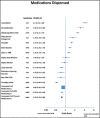Identification and evaluation of risk factors in patients with continuously uncontrolled hypertension
- PMID: 25664597
- PMCID: PMC8032169
- DOI: 10.1111/jch.12478
Identification and evaluation of risk factors in patients with continuously uncontrolled hypertension
Abstract
An aggressive strategy to manage hypertension in a large integrated healthcare organization achieved blood pressure control in 82% of hypertensive patients, as compared with 52% nationwide. It is unknown why the remaining 18% is uncontrolled. The objective of this study was to identify characteristics associated with patients whose blood pressure remains continuously uncontrolled. This nested case-control study included 1583 continuously uncontrolled cases and 7901 matched controls. Univariate analysis revealed patients who visited their primary care provider frequently (odds ratio, 0.42; 95% confidence interval, 0.39-0.46) were adherent to antihypertensive medications (odds ratio, 0.12; 95% confidence interval, 0.10-0.14), and dispensed more medications (odds ratio, 0.86; 95% confidence interval, 0.85-0.87) were less likely to be continuously uncontrolled. Patient characteristics that were associated with continuously uncontrolled hypertension were the Patient Health Questionnaire-9 score and higher body mass index. Since patients with controlled hypertension visited their provider more often, patients with continuously uncontrolled hypertension may benefit from more interaction with their healthcare system.
© 2015 Wiley Periodicals, Inc.
Figures





Similar articles
-
Prevalence and associated factors of uncontrolled hypertension among hypertensive patients: a nation-wide survey in Thailand.BMC Res Notes. 2019 Jul 4;12(1):380. doi: 10.1186/s13104-019-4417-7. BMC Res Notes. 2019. PMID: 31272496 Free PMC article.
-
Blood pressure level attainment among patients with coronary artery disease and uncontrolled blood pressure.Pharmacotherapy. 2011 Nov;31(11):1063-72. doi: 10.1592/phco.31.11.1063. Pharmacotherapy. 2011. PMID: 22026394
-
Assessment of blood pressure control in adult hypertensive patients in eastern Sudan.BMC Cardiovasc Disord. 2018 Feb 7;18(1):26. doi: 10.1186/s12872-018-0769-5. BMC Cardiovasc Disord. 2018. PMID: 29415657 Free PMC article.
-
Good knowledge about hypertension is linked to better control of hypertension; a multicentre cross sectional study in Karachi, Pakistan.BMC Res Notes. 2012 Oct 24;5:579. doi: 10.1186/1756-0500-5-579. BMC Res Notes. 2012. PMID: 23095492 Free PMC article.
-
Hypertension.Adv Kidney Dis Health. 2024 Nov;31(6):546-552. doi: 10.1053/j.akdh.2024.08.005. Adv Kidney Dis Health. 2024. PMID: 39577889 Review.
Cited by
-
STEPWISE management of clinically apparent resistant hypertension in primary care: a cluster randomised controlled trial.BMC Prim Care. 2025 Jul 2;26(1):212. doi: 10.1186/s12875-025-02885-z. BMC Prim Care. 2025. PMID: 40604411 Free PMC article. Clinical Trial.
-
Association between encounter frequency and time to blood pressure control among patients with newly diagnosed hypertension: a retrospective cohort study.J Clin Hypertens (Greenwich). 2018 Mar;20(3):429-437. doi: 10.1111/jch.13223. Epub 2018 Feb 16. J Clin Hypertens (Greenwich). 2018. PMID: 29450983 Free PMC article.
-
Controlled Blood Pressure in Iranian Patients: A Multi-Center Report.Glob J Health Sci. 2015 Aug 19;8(4):188-95. doi: 10.5539/gjhs.v8n4p188. Glob J Health Sci. 2015. PMID: 26573037 Free PMC article.
References
-
- CDC . Vital signs: prevalence, treatment, and control of hypertension—United States, 1999–2002 and 2005–2008. MMWR. 2011;60:103–108. - PubMed
-
- Lloyd‐Jones DM, Hong Y, Labarthe D, et al. Defining and setting national goals for cardiovascular health promotion and disease reduction: the American Heart Association's strategic impact goal through 2020 and beyond. Circulation. 2010;121:586–613. - PubMed
-
- Murphy SL, Xu JQ, Kochanek KD. Deaths: final data for 2010. National Vital Statistics Reports; Vol. 61 No. 4. Hyattsville, MD: National Center for Health Statistics; 2013. - PubMed
-
- Prevention of stroke by antihypertensive drug treatment in older persons with isolated systolic hypertension (SHEP). JAMA. 1991;265:3255–3264. - PubMed
MeSH terms
Substances
LinkOut - more resources
Full Text Sources
Medical

